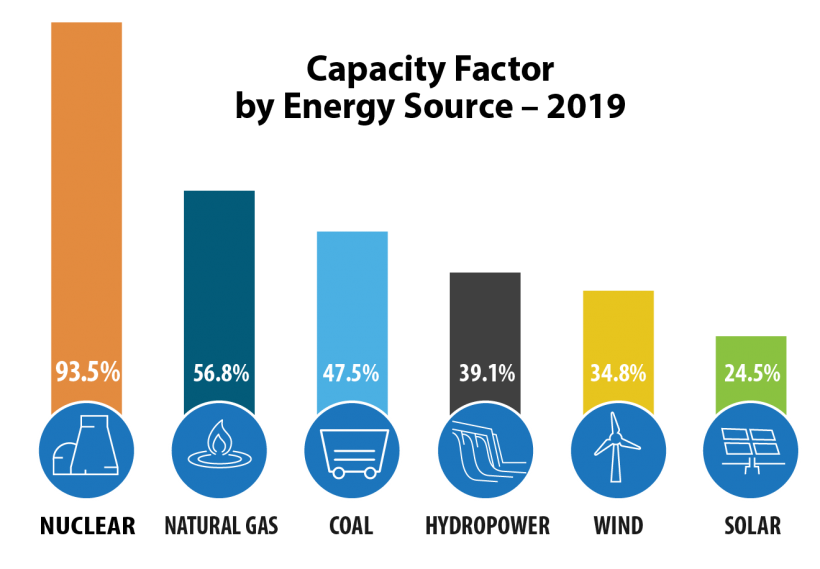Coal Plants in the U.S. are Shutting Down, and Nuclear Energy is Primed to Capitalize
Takeaways from the Columbia Energy Technology Revolution Forum
By Jackson Levin
April 14, 2022
This past March, Saoradh Enterprise Partners (SEP) attended the Columbia Energy Technology Revolution Forum, an event focused on discussing advanced nuclear technology and policy. Nuclear energy is of interest to SEP as it falls under our Carbon and Minerals sector, one of nine primary sectors that we believe make up the overall cleantech ecosystem.
Paul Dabbar, former Under Secretary for Science at the U.S. Department of Energy, was the host of this event organized by Columbia University’s Center on Global Energy Policy. To explore advanced nuclear’s potential to be in the carbon-free energy mix and how investors should view this emerging technology, Dabbar interviewed four of the leading nuclear experts in the world:
Maria Korsnick, President and CEO, Nuclear Energy Institute (NEI)
Rita Baranwal, CTO, Westinghouse Electric Company
Chris Levesque, President and CEO, TerraPower
Mike Laufer, Co-founder and CEO, Kairos Power
“We are no longer debating the merits of next-generation reactors and whether they compare to other carbon-free renewables. . . we are not talking about if, we are talking about when and how” — Maria Korsnick
The conversation is shifting. After decades of non-growth, the expert panelists claim nuclear energy has almost entirely worked its way into all decarbonization by 2050 solutions. This change in sentiment is due to breakthrough innovations and historic funding from President Biden and congress.
Some of this funding goes towards the Advanced Reactor Demonstration Program (ARDP). The ARDP will drastically speed up the demonstration process for advanced reactors by awarding cost-sharing partnerships to the most innovative nuclear companies in the United States. Chris Levesque and Mike Laufer, two early award recipients from the ARDP, spoke at the event.
Chris Levesque and his company, Terrapower, which is backed by Bill Gates, might be America’s next dominant reactor. Terrapower utilizes an advanced reactor with an integrated molten salt storage system and natural load-following capabilities, allowing its normal output of 345 MW to increase to 500 MW for more than five and a half hours. This storage function becomes increasingly valuable as the grid shifts towards intermittent renewables. Terrapower’s first reactor, based in Wyoming at the site of two retiring coal plants, will be operational within the next seven years.
Mike Laufer’s company Kairos Power is slightly behind in commercial development, as they have a different goal in mind. While they have a reactor technology of their own, Kairos Power believes that success won’t come until nuclear energy is cost-competitive with natural gas. They are pioneering new methods of demonstration along with lower safety significance on certain parts of their plant, which they believe can help them achieve their goal to reduce the cost of nuclear energy not by tens of percentage points but by multiple factors.
Aside from the ARDP unlocking historic innovation, the decommissioning of coal-fired power plants is another key tailwind for nuclear growth. This trend is playing out worldwide as 21 countries have committed to completely phasing out coal, and final investment decisions (FIDs) for coal plants decreased by 80% between 2015 and 2020. In the United States alone, more than 110 coal plants are set to retire by 2040. Figure 1 shows how coal relates to other energy sources when looking at capacity retirements in 2022.
Figure 1: Energy Information Agency
Declining coal capacity in the U.S. is good news for cleantech as a whole, but there is still a long way to go. This graphic from the International Energy Agency (IEA) shows where we stand currently compared to what the Net Zero Scenario requires by 2050.
Figure 2: International Energy Agency
Certain energy sources included in non-fossil fuel power, such as wind and solar, are intermittent. Intermittency, in the context of renewables, means that the peak demand for energy from the public does not always align with peak supply. The gap that emerges shows the need for a strong baseload energy source combined with those renewables, ensuring a reliable grid throughout the day.
For a long time, that baseload energy was coal. More recently, coal is being overtaken by natural gas, which emits less greenhouse gas emissions (GHGs) but is still included in the fossil-fuel category. Nuclear energy fills that role without emitting GHGs during power generation. Capacity factor is a key metric to assess an energy source’s ability to provide the baseload energy that pairs with intermittent renewables.
Figure 3: U.S. Department of Energy
Capacity factor indicates how frequently an energy source reaches its peak generation capabilities. It also outlines the past need for natural gas and coal and the potential need for nuclear power in the future. Wind and solar might be the fundamental energy sources of the future, but it won’t matter if we continue to support them with fossil fuels.
A decrease in coal capacity and a net-zero plan heavily reliant on intermittent renewables like solar and wind provides a huge opportunity for nuclear energy. Maria Korsnick and the NEI, an organization with considerable political influence, are attempting to preserve the existing U.S. nuclear fleet and promote faster demonstrations of newer advanced technologies to capitalize on that opportunity.
Aside from its high capacity factor, nuclear technology holds additional advantages over other energy sources. These advantages are on display at the Westinghouse Electric Company, whose technology is currently responsible for nearly 50% of global nuclear power capacity. Their CTO, Rita Baranwal, described their next-generation plant called the eVinci Micro-Reactor. The eVinci reactor is ideal for remote locations and a decentralized grid for a few reasons. The plant has a refueling period of 3-4 years compared to a few weeks, autonomous load-following capabilities, and a 48-hour grace period to arrive on-site if a shutdown occurs. The eVinci reactor takes up one acre of land on a per-unit basis. To have an equivalent power output from solar would require 50-70 acres, and wind would be 275-380 acres.
The panelists are pushing for two main things to drive further innovation in the nuclear sector:
An increase in investments
Further clarity on nuclear’s standing in green portfolio standards
If both are achieved, nuclear energy may soon become more cost-competitive with gas making it a legitimate clean alternative baseload source. Inexpensive nuclear energy paired with solar and wind energy is what the experts at the Columbia University event describe as the perfect backbone for a 2050 decarbonized grid.
Whatever happens, SEP plans to keep a close eye on the growth occurring in the nuclear space as we continue to monitor the dynamic and rapidly evolving cleantech ecosystem.
Jackson Levin is an analyst intern at SEP. He is a student in Environmental Studies at the University of Colorado Boulder.





